Weekly Email – The Last Sunday after Trinity
Documents
Dear friends,
I am so sorry that our Autumn Study Day had to be cancelled at the last minute earlier this week, and also that there has been disruption to our usual pattern of Masses. Upon my return from The Netherlands on Tuesday, I came down with a terrible flu-like bug, which has put me in bed ever since then. I have taken several COVID tests, all of which were negative, so I am reasonably sure it, at least, isn’t the Coronavirus, but it has, nonetheless, laid me pretty low.
I realise many people will have been looking forward to the study day and I can only apologise. I will try to reschedule the event for a future date and will let you know more once details emerge.
Fr Peter
Church Times Book Review
Fr Peter’s new book on the Transfiguration entitled, “Patristic Perspectives on the Transfiguration: Interpreting Vision,” was reviewed last week in the Church Times. The review can be found here.
The book’s launch will take place at All Saints’ on Monday 31st October at 7.30 pm. It will follow First Evensong and Benediction of All Saints’ Day, which will take place at 6.30 pm and will include a drinks party. All parishioners of All Saints’ are cordially invited to the book launch.
Guest preacher: The Revd Clare Dowding
We look forward to welcoming our Area Dean, the Revd Clare Dowding, to preach next Sunday at the 11.00 am High Mass. Clare is Rector of St Paul’s, Marylebone and Area Dean of the Westminster Marylebone Deanery.
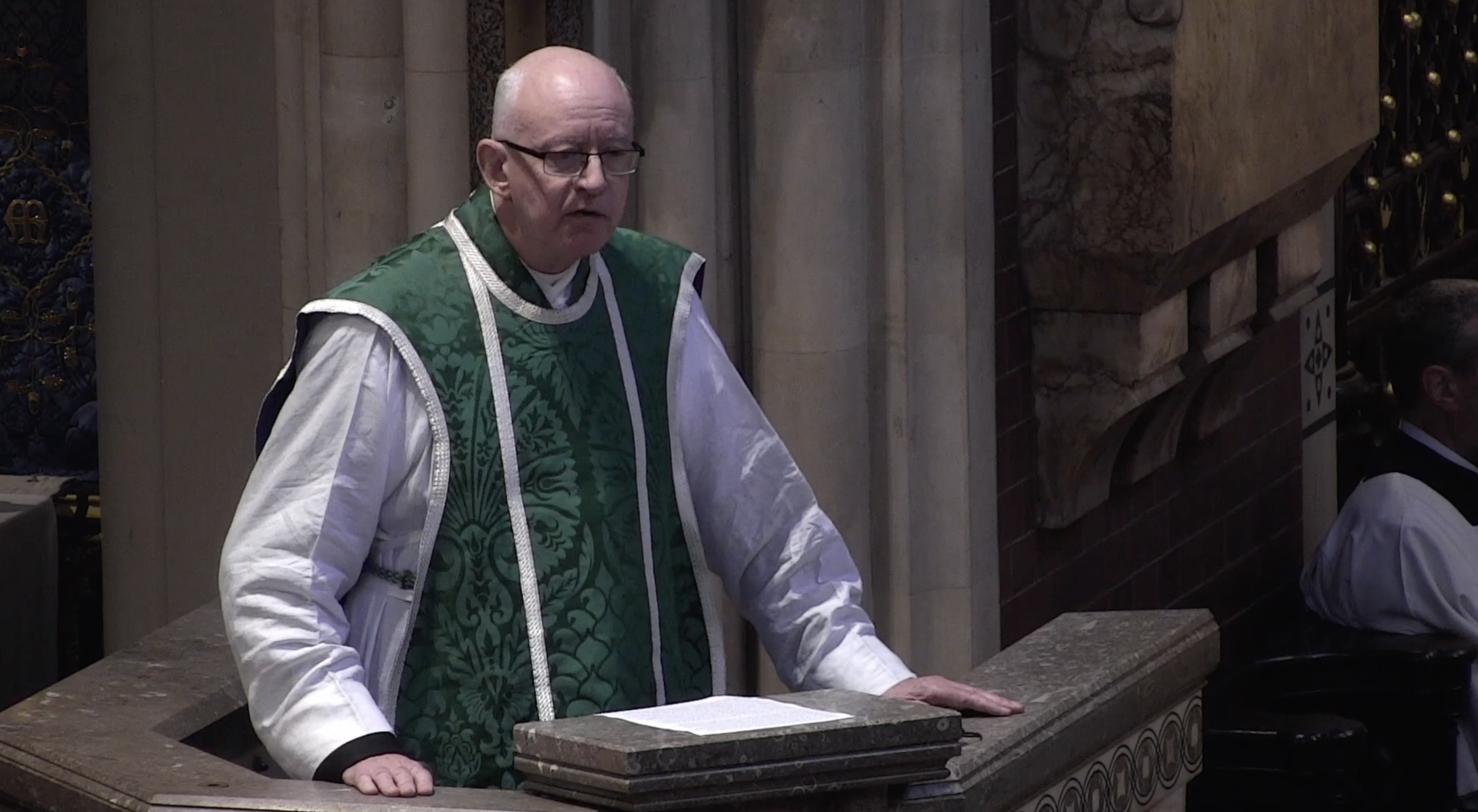
In Sunday’s homily, Fr Julian explored the story of Jacob wrestling with the angel. All our wrestlings, fears, and doubts eventually find their resolution in God whose nature is love, and whose property is always to have mercy. Through human wondering and confusion, we are changed and made ready by God to receive his forgiveness. Watch again here.
The Treasures of Aachen
On my recent visit to Limburg, I was able to spend a day in Aachen, just over the border in Germany, experiencing something of the breath-taking Christian patrimony of that city.
To cut a very long story short, Aachen was the location Charlemagne chose as the place for his “retirement” towards the latter half of his life. He built a magnificent palace and constructed a chapel for court liturgies, which became famous as one of the most splendid churches of its age and the setting for later coronations of Holy Roman Emperors until the 16th century. It now forms part of the Cathedral. At the time of its construction, it was the tallest building in Europe.
Charlemagne’s Palatine Chapel is an extraordinary construction. It is an eight sided round building, based on the beautiful church of San Vitale in Ravenna. A close connection exists between the Palatine Chapel and Ravenna, which Charlemagne visited three times. Charlemagne had whole columns of marble brought from temples and churches in Ravenna in order to be included in his new palace chapel. The dome was eventually covered in mosaics inspired by the artistry of that city. Charlemagne wanted to embellish his imperial credentials by creating a little Ravenna north of the alps.
So highly prized were the Ravenna columns brought to decorate the church that when Napoleon invaded Aachen, he took them back to the Louvre for display there! Once Napoleon was defeated, the columns were returned to Aachen, but they found a number of them had been built into a load bearing wall in Paris and so couldn’t be returned without pulling the Louvre down. To this day, a small number of the famous Ravenna pillars in Aachen are replicas, and the originals remain in Paris.
By the time of the Medieval period, a building inspired by the Sante Chapelle, Paris, was added onto Charlemagne’s round church. It produces the strangest church building you will ever enter – a round nave with a soaring gothic chancel beyond. The Gothic portion of the building was used for the display of the relics the church had amassed and particularly as the later location of Charlemagne’s own remains preserved in an enormous golden casket. The gothic chapel has some claim to be the first “museum” space of Europe – a building open to the public which you could move around to observe and look at precious objects.
In a gallery opposite the altar in the round church is to be found “Charlemagne’s throne.” Some historians think it actually post-dates Charlemagne’s life. However, we can be sure that it was constructed out of stones brought from the Church of the Holy Sepulchre in Jerusalem. I asked if visitors were allowed to sit in the chair, and told this is strictly forbidden – especially as the last person known to have sat on the throne was Hermann Göring!
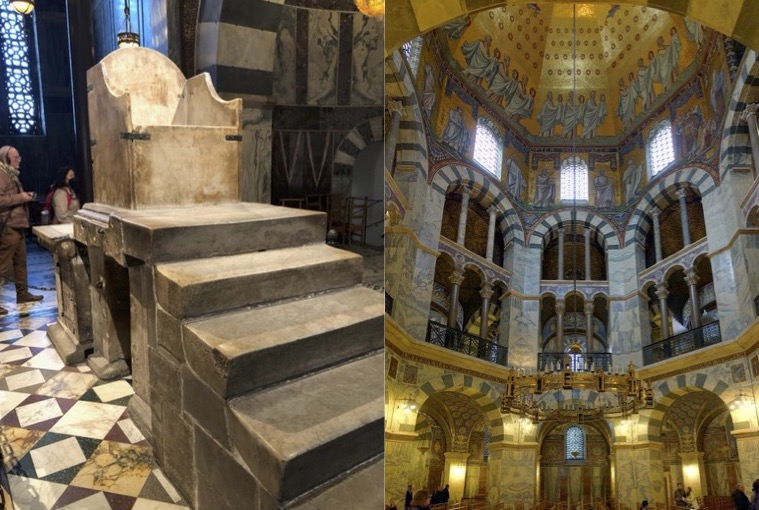
Charlemagne’s throne on the left, and the Palatine Chapel not he right with columns on the upper stories from Ravenna.
A further ravishing highlight of my visit to Aachen was the visit to the cathedral treasury. It is stuffed full of the most amazing items and probably represents the finest collection of Northern European art from the period of the Carolingian Renaissance and early Medieval period in existence. Amongst the dozens of glittering monstrances, chalices, and reliquaries, the most famous object is the 14th century bust of Charlemagne containing a portion of his skull.
The highlight of the whole visit for me was finally seeing in the flesh a remarkable object called the Lothair Cross, which is kept in the cathedral treasury. Its creator re-used jewels, cameos, and gems from the ancient world to create an stupendous jewelled processional cross. In fact, the jewelled side is probably the “back” of the cross, as a corpus image is engraved into the other side, which was probably considered the front.
The most notable thing about the cross is the re-use of a Roman cameo depicting Caesar in the centre. Academic opinion is divided on the question of how we are to interpret its presence. Some think the artists may have imagined it to be an image of Christ. There is, for example, evidence from the same period of an aqua marine intaglio of Augustus’ daughter Julia being re-used as an image of the the Virgin Mary. Others think an image of an ancient emperor was intentionally used to draw comparisons between the Caesars and Charlemagne’s legacy. It could be that one side represents “church” and the other “state” – held together in the person of the emperor as guarantor of a just Christian polity.
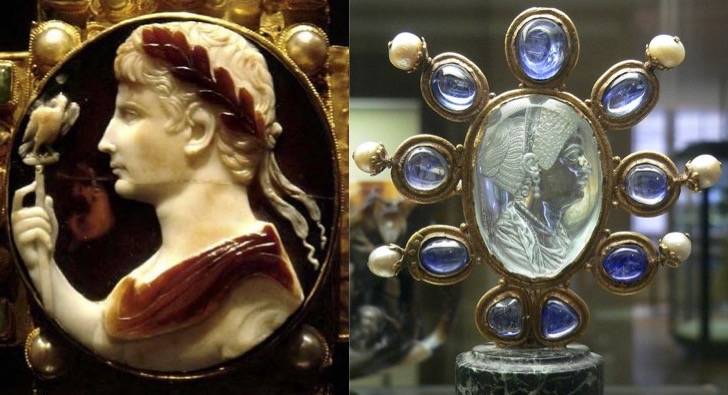
The cameo of Augustus on the right, from the Cross of Lothair; the aqua marine intaglio of Julia, Augustus’ daughter, re-used as an image of the Blessed Virgin Mary in the Escrain de Charlemagne.
I first came across discussion of this cross in relation to doctoral research I was undertaking into the Transfiguration image at Sant’Apollinare in Classe. There, the Transfiguration is presented as an image of a jewelled cross with a face in the middle. Some have wondered whether the Lothair Cross echoes this mosaic image in Ravenna and was inspired by it, as a further echo of the imperial city of Ravenna. I, personally, consider it unlikely, but it is tantalising idea which cannot entirely be excluded. I was so excited finally to see an object in the flesh which I had only ever studied in books until that point.
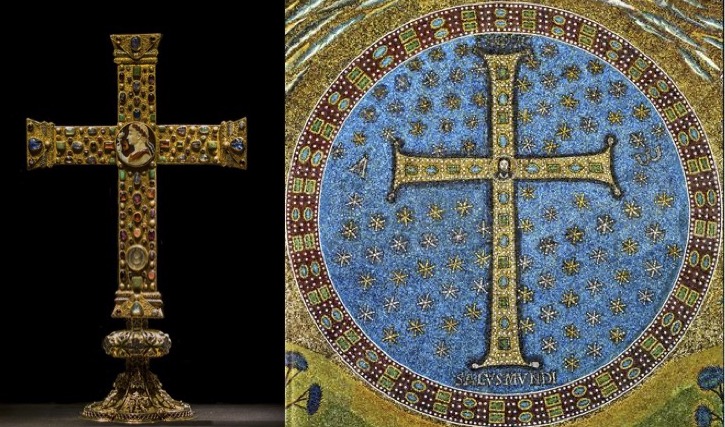
The Cross of Lothair on the left and the image of the Transfiguration in Classe, Ravenna, on the right. Some have wondered if the former is a homage to the latter.
I left the Aachen treasury in a state of stupefied wonder. Luckily, nearby is a wonderful coffee shop called Nobis, which sells the city’s great delicacy – “Printen” gingerbread. It is absolutely delicious and just what is needed to revive the visitor overcome by the glories of the age of Charlemagne – especially their “Domspitze” biscuits, a marzipan filled gingerbread in the shape of the cathedral’s Carolingian dome, of which I am sure Charlemagne would personally approve!
Fr Peter
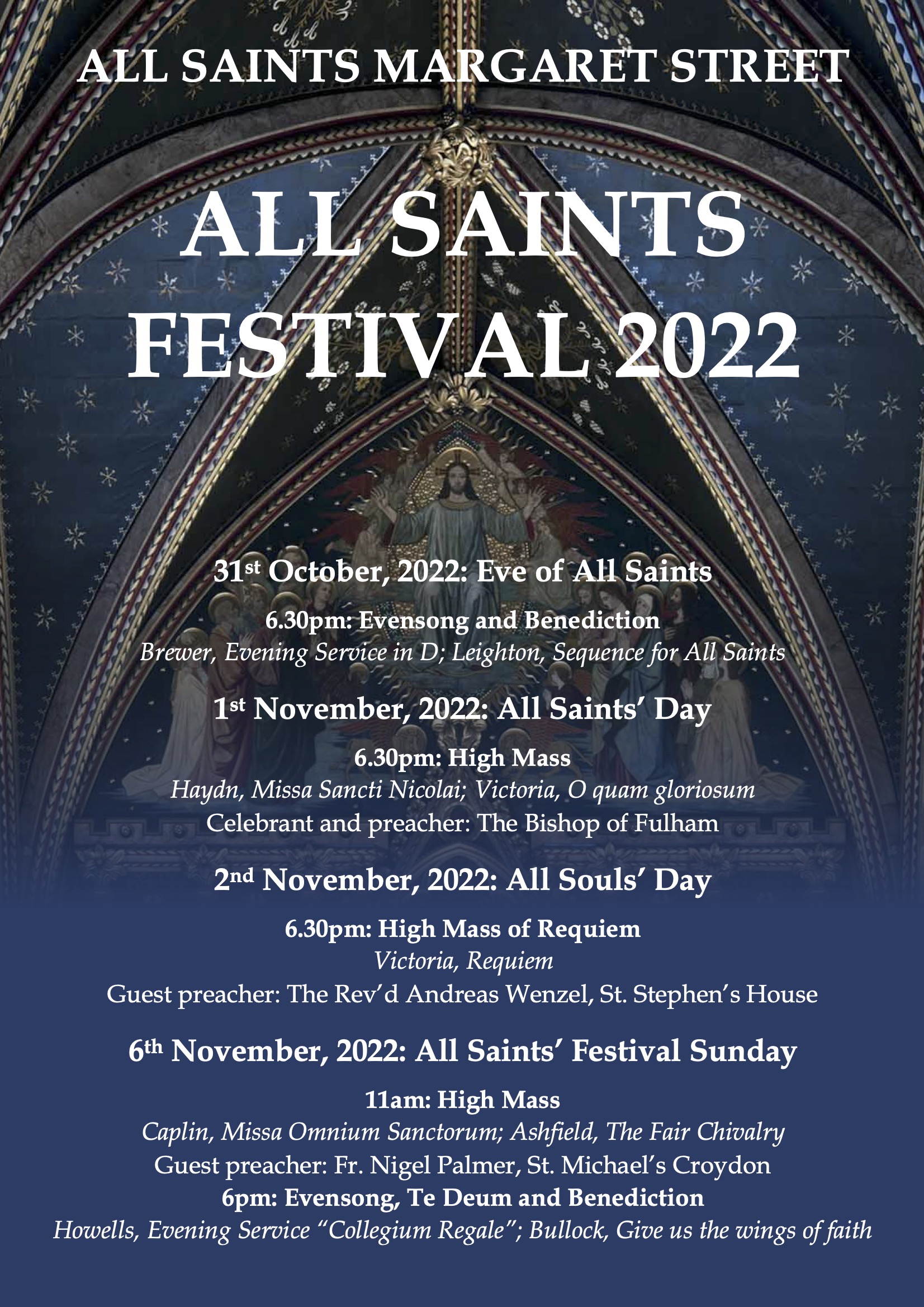
Links for Sunday
The links for the livestream and service sheet for this Sunday’s High Mass are at the end of this email.
Evensong and Benediction, offered this week in memory of Benedict Alois Loidl, is at 6pm on Sunday. The service will be live-streamed, via the link here, and the service sheet is also available at the end of this email. The music includes Sumsion’s Evening Service in A and Bairstow’s Jesu, grant me this, I pray.
Flowers
The flowers at the statue of Our Lady this Sunday are given by Simon Rainey and Christiane Loidl in memory of Benedict Alois Loidl, whose anniversary falls at this time, and in whose memory Evensong and Benediction will be offered on Sunday.
We are looking for volunteers to help with the flowers in church and the Courtyard Garden. If you have a particular talent for flower arranging or gardening and would like to help from time to time or on a regular basis, please contact Shawn on 07988 287 662 or shawnwilbe@outlook.com.
If you would like to make a donation for flowers or the garden, please contact Shawn.
Mary Phyllis Andrews RIP
We were sorry to learn of the death of Mary Phyllis Andrews, on Saturday 9th October, 2022. Mary was the widow of Fr. Tony Andrews, who was the curate of Fr. Cyril Tomkinson, seventh Vicar of All Saints’. She was a nurse and parishioner of All Saints’ when she met Fr. Andrews: the two were married at All Saints’ in the 1950s. Fr. Andrews later became Vicar of All Saints’ Babbacombe and died in 1999. Mary’s funeral is expected to take place in Devon later this month. We continue to pray for Mary at the Daily Mass.
Prayer List
The sick
Fr. Harry Hodgetts, Elizabeth Lyon, James Shrimpton, Gloria Fleming, David Craig, Martin Berka, James Rodger, Amanda Barrett, Richard Weed, Keith Postance
The faithful departed
Sue Robinson, Mary Andrews, Julie Wilcox, Benedict Loidl (2008)
Anniversaries of death
October 23rd – Roy Prince
24th – Eva Dean, Ron Keating, Peter Laister Pr.
25th – Reginald Thompson
26th – Gwendoline Freeman, Joseph Harding
28th – Dorothy Gartside, William Lloyd Webber, Phyllis Richards, John Gaskell Pr., David Trendell
29th – Sr. Dorothy Hilda
30th – Tharu Tharakan, John Todd
The Friends of All Saints’
October 23rd – Pat Phillips, Colin Podmore, Nick and Cecilia Powell, Simon Pusey, Simon Rainey
24th – Carlos Remotti-Breton, Steve Rice, Hilary Rodger, Fr. Jim Rosenthal, Mossman Roueche
25th – Greg Round, Mary Sherred, Fr. Peter Simpson, Ingrid Slaughter, Gwynedd Sooke, Richard and Louise Stallwood
26th – Jason Stewart, Ian & Veronica Summers, Sebastian Taite-Ellis, Andrew Thompson, Pat Thompson
27th – Charles Thomson, James Thomson, Jeremy Thorp, Daniel Turner, Christine Vaughn Lillie
28th – Sam Walsh, Christopher Walsh, Christopher Waterhouse, Philip Wayne, Fr. Benjamin Weitzmann,
29th – Michael Westcott, James White, Matthew Whittaker, Tim Widdowfield, David Wilcox, Ian Wilson
30th – Juliet Windham, Philip Wood, Martin Woods, Martin Wooley, David Wright, Fr. John Wylam
Service times this week
Saturday 22nd October – St. John Paul II
12.00 noon Mass
6.30 pm Vigil Mass of Sunday
Sunday 23rd October – Last Sunday after Trinity
11.00 am High Mass
5.15 pm Low Mass
6.00 pm Evensong and Benediction in memory of Benedict Loidl
Monday 24th October – St. Anthony Mary Claret
12.00 noon Mass
6.30 pm Mass
Tuesday 25th October – Ss. Crispin and Crispinian
12.00 noon Mass
6.30 pm Mass
Wednesday 26th October – St. Chad
12.00 noon Mass
6.30 pm Mass
Thursday 27th October – Feria
12.00 noon Mass
6.30 pm Mass
Friday 28th October – Ss. Simon and Jude
12.00 noon Mass
6.30 pm Mass
Saturday 29th October – Feria
12.00 noon Mass
6.30 pm Vigil Mass of Sunday
Sunday 30th October – Last Sunday after Trinity
11.00 am High Mass
5.15 pm Low Mass
6.00 pm Evensong and Benediction
